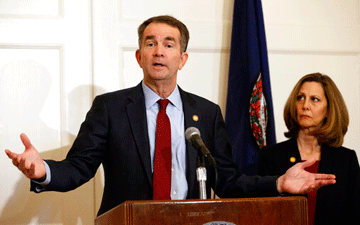
(AP Photo/Steve Helber)
Don Heider is the Executive Director of the Markkula Center for Applied Ethics. Views are his own.
The latest case involving blackface came about when the Virginia Governor was confronted with a photograph in his medical school yearbook of someone in blackface standing next to another individual in a Ku Klux Klan hood.
It’s a revelation that has come close to ending Ralph Northam’s ability to serve as governor. Why? Because a person putting on make-up to look like a black person has a sordid history in the U.S. It harkens back to minstrel shows, a form of entertainment which systematically dehumanized African Americans, reducing them to simple stereotypes such as Mammy, Uncle Tom, etc.
This case also raises interesting questions about a person’s past acts, and whether those acts should restrict their ability to hold elected or appointed office or to even serve in any leadership role.
If we take our own framework for ethical decision making and apply it to the Northam case, it offers some interesting insights into the incident. There were at least two separate issues in the case within the first two days of the controversy. First, there is the very act of wearing blackface. Second, how one deals with the revelation. In this case, Northam first apologized for wearing blackface in the photograph, but within 24 hours denied it was him in the photo, although he admitted to wearing black face on another occasion.
The Markkula Center’s framework asks us to first get the facts about a case. Northam has made that very difficult. Was he indeed in the yearbook photo or wasn’t he? Perhaps more disturbing, how could you not recall if you had been photographed or attended an event in black face? This suggests either the governor was beginning to suffer early stages of senility or he was flat out lying. Or does this mean the occasions in which Northam wore black face were so numerous, he couldn’t separate this one from the others? A few days later, Northam confirmed he was in the yearbook photo but did not say whether he was wearing the KKK outfit or blackface. The possibility of him dressed in an outfit identified with an organization with years of horrific violence against blacks and others perhaps is more disturbing than the possibility that he had worn blackface.
Our framework for ethical decision making asks: “Could this decision or situation be damaging to someone or to some group?” The answer here is clearly yes. For African Americans, blackface is a constant reminder of the painful negative stereotypes from the past, a demeaning weapon of oppression. A Klan outfit calls to mind lynching and burnings, almost the penultimate example of what scholar Paul Lester termed an image that injures.
Given this and having the leader of a state acknowledge his role participating in this kind of bigotry is shocking, and that the participation took place in 1984 is even more shocking. We are not talking about actions that took place in Jim Crow America, so how long can we overlook ignorance and neglect of the country’s racist past? Is the cutoff 1970, 1980, 2019? As the University of Washington’s David Leonard wrote in an essay in the Huffington Post in 2012; “The ability to be ignorant, to be unaware of the history and consequences of racial bigotry, to simply do as one pleases, is a quintessential element of privilege. The ability to disparage, to demonize, to ridicule, and to engage in racially hurtful practices from the comfort of one’s segregated neighborhoods and racially homogeneous schools reflects both privilege and power. The ability to blame others for being oversensitive, for playing the race card, or for making much ado about nothing are privileges codified structurally and culturally.” Northam represents this position of power and willful ignorance, and it’s a position and lack of awareness that seemingly has not changed.
Now Northam has announced through the Washington Post that he will confront the state’s deep and lingering divisions over race. Our framework for ethical decision making encourages people, when confronted with an ethical issue to ask, “Which option will produce the most good and do the least harm? Which option best respects the rights of all who have a stake? Which option best serves the community as a whole, not just some members?” In this case, the governor seemingly has selected the option that serves him the best; remaining in a position of power. If the state of Virginia is to do serious work on racial reparation, a perpetrator of racial hatred must be completely misguided if he believes he is the best person to lead that work. Virginia has eight and a half million residents, certainly the governor could find one person more qualified than himself to lead this effort, and in fact, to lead the state period.
Should someone who wore blackface in the past hold high elected office, or sit as the leader of a corporation or organization? Of course, each case would have its own circumstances. Though given the damaging symbolism blackface represents, the first step would have to be an honest admission and acknowledgement, which would include the willingness to step down. Neither has been visible in the case of Ralph Northam.
References
Paul Lester, Images That Injure, Praeger; 1996.
David J. Leonard, Just Say No to Blackface: Neo-Minstrelsy and the Power to Dehumanize, Huffington Post, 08/08/2012.